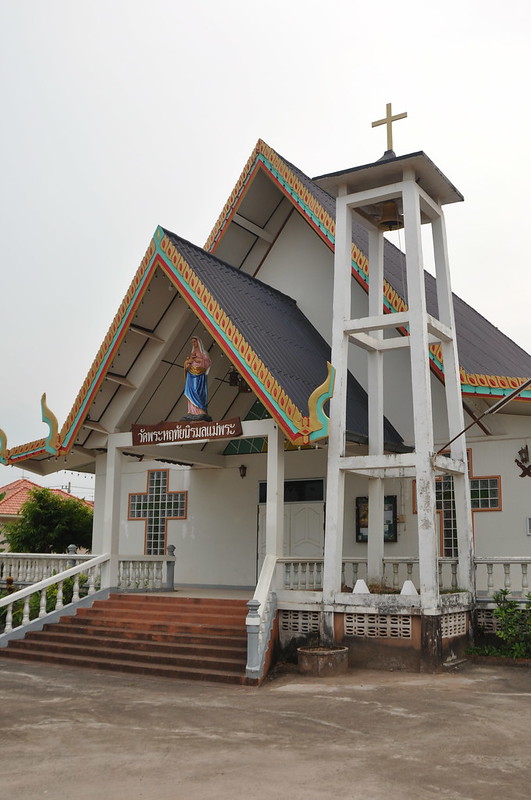A few days later, we spotted a lizard on a ficus tree in our yard. This lizard almost seemed to line up the stripes on his body with the stripes on the tree. This made him rather difficult to spot.
This compares well with what it is like to live in another culture. Sometimes, we're more like the moth and our behavior and appearance clash with the culture, making it easy to mark us as a disrespectful foreigner.
 |
| A not-so-lizard-like adaptation to Thai culture |
Sometimes, we do a better job at adapting local ways and we blend in a bit better, more like the lizard.
The apostle Paul, though he was a Jew, tried to blend in with the non-Jews when he worked with them. I don't think he forsook being Jewish, it just seems like he didn't want his Jewish ways become barriers to non-Jews coming to faith in Christ.
20 When I was with the Jews, I lived like a Jew to bring the Jews to Christ. When I was with those who follow the Jewish law, I too lived under that law. Even though I am not subject to the law, I did this so I could bring to Christ those who are under the law. 21 When I am with the Gentiles who do not follow the Jewish law, I too live apart from that law so I can bring them to Christ. But I do not ignore the law of God; I obey the law of Christ.
22 When I am with those who are weak, I share their weakness, for I want to bring the weak to Christ. Yes, I try to find common ground with everyone, doing everything I can to save some. 23 I do everything to spread the Good News and share in its blessings. 1 Corinthians 9:20-23 (NLT2)
When we preach the gospel in another culture, it is a constant challenge to present the message as unencumbered as possible from Western and personal cultural baggage. It is not easy and not everyone agrees with how far we can go to make the gospel palatable. Some churches go so far as to make shrines to Christian saints that look identical to shrines to local deities. Some put symbols of Naga (the serpent demon) on their rooftops.
While those are more extreme adaptations, other things are not so clear. For example, do we use the word karma, along with the term sin when talking about sin, since the Thai people use the term sin in a more narrow sense.
Other examples are found in translating special words. There is a Thai term for the hall where the Buddhist monks do their teaching called Salatham. In the Catholic bible they used this term for "synagogue", which seems appropriate. Most Protestant translations wanted to distinguish the Jewish term from Buddhist concepts, so they simply reversed the syllables, i.e. Thamasala. One of the newer Bible translations did away with the concept altogether and refers to the synagogue as the "meeting place of the Jews". Which one is best?
These are just a couple many instances where we have to think about how we present the gospel in the local culture. While we Christians want to be like the lizard and blend in with our environment, we still want to remain a lizard and not become a tree.
20 When I was with the Jews, I lived like a Jew to bring the Jews to Christ. When I was with those who follow the Jewish law, I too lived under that law. Even though I am not subject to the law, I did this so I could bring to Christ those who are under the law. 21 When I am with the Gentiles who do not follow the Jewish law, I too live apart from that law so I can bring them to Christ. But I do not ignore the law of God; I obey the law of Christ.
22 When I am with those who are weak, I share their weakness, for I want to bring the weak to Christ. Yes, I try to find common ground with everyone, doing everything I can to save some. 23 I do everything to spread the Good News and share in its blessings. 1 Corinthians 9:20-23 (NLT2)
When we preach the gospel in another culture, it is a constant challenge to present the message as unencumbered as possible from Western and personal cultural baggage. It is not easy and not everyone agrees with how far we can go to make the gospel palatable. Some churches go so far as to make shrines to Christian saints that look identical to shrines to local deities. Some put symbols of Naga (the serpent demon) on their rooftops.
 |
| Catholic Church with Naga symbols on the ends of the eaves |
While those are more extreme adaptations, other things are not so clear. For example, do we use the word karma, along with the term sin when talking about sin, since the Thai people use the term sin in a more narrow sense.
Other examples are found in translating special words. There is a Thai term for the hall where the Buddhist monks do their teaching called Salatham. In the Catholic bible they used this term for "synagogue", which seems appropriate. Most Protestant translations wanted to distinguish the Jewish term from Buddhist concepts, so they simply reversed the syllables, i.e. Thamasala. One of the newer Bible translations did away with the concept altogether and refers to the synagogue as the "meeting place of the Jews". Which one is best?
These are just a couple many instances where we have to think about how we present the gospel in the local culture. While we Christians want to be like the lizard and blend in with our environment, we still want to remain a lizard and not become a tree.



No comments:
Post a Comment